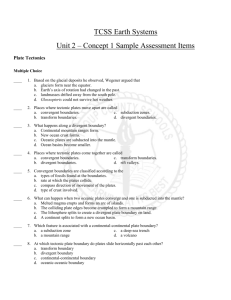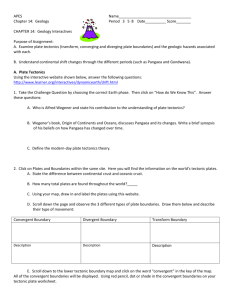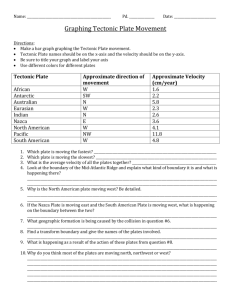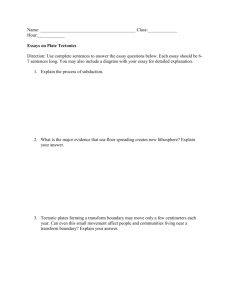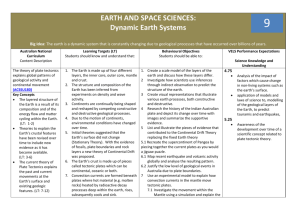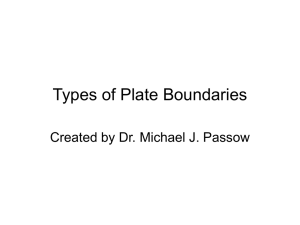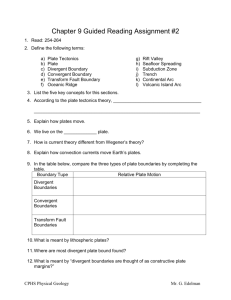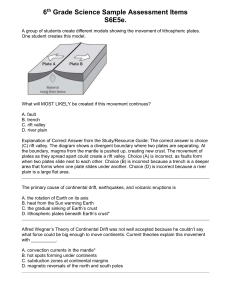What are the Types of plate boundaries?
advertisement
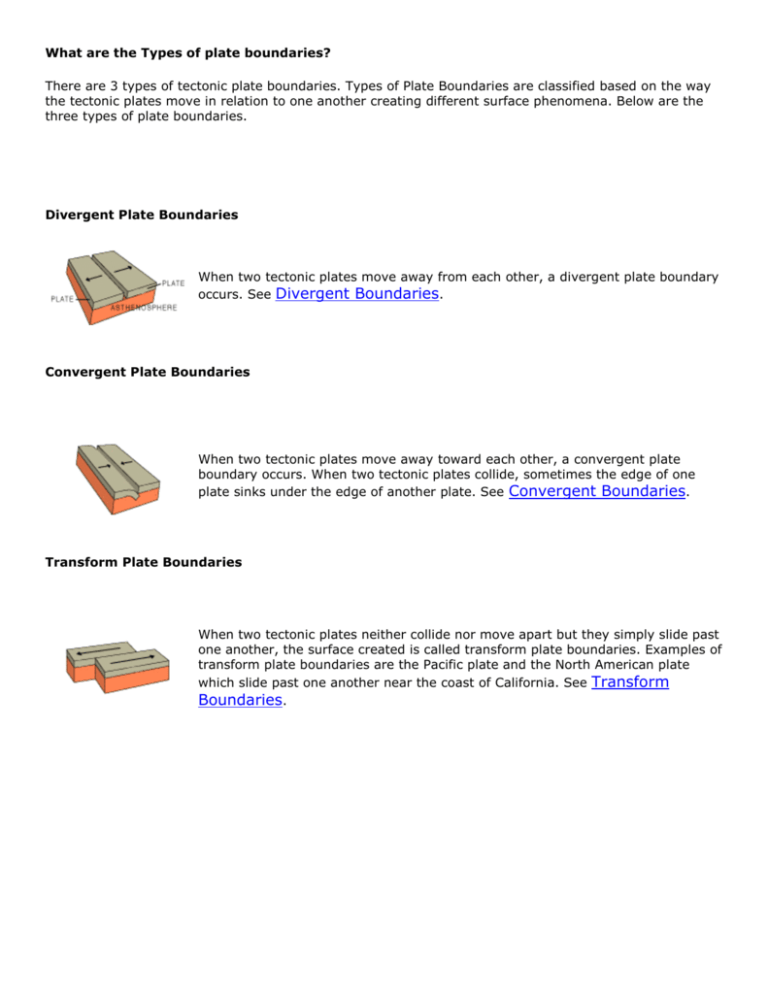
What are the Types of plate boundaries? There are 3 types of tectonic plate boundaries. Types of Plate Boundaries are classified based on the way the tectonic plates move in relation to one another creating different surface phenomena. Below are the three types of plate boundaries. Divergent Plate Boundaries When two tectonic plates move away from each other, a divergent plate boundary occurs. See Divergent Boundaries. Convergent Plate Boundaries When two tectonic plates move away toward each other, a convergent plate boundary occurs. When two tectonic plates collide, sometimes the edge of one plate sinks under the edge of another plate. See Convergent Boundaries. Transform Plate Boundaries When two tectonic plates neither collide nor move apart but they simply slide past one another, the surface created is called transform plate boundaries. Examples of transform plate boundaries are the Pacific plate and the North American plate which slide past one another near the coast of California. See Transform Boundaries. *What are divergent boundaries? Divergent boundaries occur when tectonic plates are moving apart. When tectonic plates move apart, new crust is formed because a space is created between the two tectonic plates. Divergent boundaries can create large fault zones in the oceanic ridge system. Examples of divergent boundaries of tectonic plates The Mid-Atlantic Ridge is a good example of a divergent boundary created by tectonic plates moving apart. East Pacific Rise and East African Great Rift Valley are other examples of divergent boundaries of tectonic plates. *What are convergent boundaries? Convergent boundaries occur when two or more tectonic plates are move toward one another and some colliding. There are several geological activities that could happen at convergent boundaries. When two tectonic plates converge, the denser plate slides underneath the other. This process is called subduction. Active volcanoes often form in the subduction zones. Mountain ranges are often formed when two continental tectonic plates collide. Below are examples of what happens at convergent boundaries. If an oceanic tectonic plate meets a continental tectonic plate, then the oceanic plate will slide under the continental plate and the oceanic crust will become part of the Earth's mentle. If two oceanic tectonic plates converge, then denser plate is subducted under the other forming a deep sea trench. Examples of convergent boundaries of tectonic plates The Nazca Plate is an example of a convergent boundary sliding below the South American Plate. The Marianan Trench in the western Pacific Ocean is where the Pacific Plate converges with the Philippine Plate. The Himalayas and the Tibetan Plateau are among the most dramatic effects of convergent boundaries of tectonic plates. The Himalayas, an example of Convergent Boundaries. *What are transform boundaries? With transform boundaries, when tectonic plates come near each other horizontally, the neight colliede nor pull apart but they slide past each other forming large transform faults or fracture zones. No new earth crust is formed and no existing crust is lost in transform boundaries. Many earthquakes occur along faults created by transform tectonic boundaries. Where to find transform boundaries? Most of the Earth's transform boundaries of tectonic plates are on the ocean floor along the edges of the mid ocean ridges. There are a few transform boundaries on land. Examples of transform boundaries of tectonic plates The most famous of the transform boundaries is the San Andreas Fault zone in Southern California where the Pacific Plate and the North American Plate slowly grind past each other. Picture of San Andreas Fault in Southern CA, showing transform boundaries of tectonic plates. What is the Lithosphere?Lithosphere is the outermost layer of the earth's crust. Lithosphere is the only part of the earth that is accessible to us. Lithosphere is cold, solid and rigid whereas as Asthenosphere is partially molten. The lithosphere is broken up into large solid plates called tectonic plates. These tectonic plates move around which are the basis of plate tectonics. How many miles deep is the lithosphere? The lithosphere is about 40 - 250 miles deep or 60 - 400 kilometers deep. What is the asthenosphere and where is the asthenosphere is located? The asthenosphere is the part of the earth just below the lithosphere, as seen on the diagram of the Lithosphere and Asthenosphere above. The asthenosphere is white hot and can be deformed. The asthenosphere is not liquid but there is a small amount of melted rock there. The asthenosphere is more solid than liquid. How thick is the asthenosphere? The asthenosphere is about 400 - 700 kilometers deep or 250 - 435 miles thick. Faults usually occur along tectonic plate boundaries, whether it be convergent boundaries, divergent boundaries or transform boundaries. Earthquakes often occur in areas that contain faults. But there is more than one type of fault. Most faults cannot be seen since they are buried deep in the earth's crust. Each of the three types of faults below can occur at any type of tectonic plate boundaries. Similar to how tectonic plates move, rocks on either side of the faults also move in similar manners. Three types of faults Strike Slip Faults Strike slip faults are the main fault along transform plate tectonic boundaries. In a strike slip fault, the blocks of rock move sideways as they pass each other on a horizontal plane. Normal Faults Normal faults usually occur at divergent plate boundaries. The rocks or seafloor spread apart and new crust is formed. With normal faults, the rocks on one side of the normal fault moves downward against the rocks on the other side. Reverse Faults Reverse faults are the opposite of normal faults. The rocks on one side of a reverse fault moves upward. This movement of rocks at reverse faults often causes earthquakes. Earthquakes In plate tectonics and the study of earthquakes, the first question that most people ask is what causes earthquakes. We have already discussed tectonic plates movements and different plate boundaries. We also mentioned that convergent boundaries, divergent boundaries and transform boundaries can create fault zones and earthquakes are caused by faulting. San Andreas Fault in Southern California is a classic example of a fault zone where earthquakes often occur. Motion of tectonic plates can set off earthquakes in areas that contain faults. Below are some Earthquake facts to help you understand and be more familiar with plate tectonics theory. You can use these earthquake facts in a quiz at school or as a game for fun. If you want to add more earthquake facts to our list, please use our contact form to add your earthquake facts. List of Earthquake Facts Fact #1: Earthquakes can cause enormous waves in the ocean. Fact #2: Earthquakes undersea can cause undersea landslides which can cause gigantic wave on the ocean surface called tsunami. Fact #3: On December 26, 2004, a series of tsunamis caused by an earthquake under the Indian Ocean killed hundreds of thousands of people in Southeast Asian countries including Thailand and Indonesia. Fact #4: There are two types of Earthquake waves; the body waves which travel deep into the earth and surface waves. Fact #5: In 1906, an earthquake almost destroyed San Francisco. The earthquake responsible was known as The Great San Francisco Earthquake of 1906. The violent earthquake lasted for almost 45 seconds destroying buildings and streets all over San Francisco. The San Francisco Earthquake was estimated to be about 8.3 making it one of the most powerful earthquakes ever to hit North America. Fact #6: The size of the earthquake depends on the size of the break in the fault.

